History
 With the development of weapons of mass destruction, comes the distinct possibility of serious accidents. For the most part the weapons are designed to be fairly stable under most circumstances, but that was not always the case, nor is it always the case today. Nitroglycerin, when it was first developed was a volatile liquid that would explode if it was shaken too much. Many miners, hauling the liquid to the mines by wagon, were killed when the nitroglycerin was shaken. In fact it was considered such a hazardous occupation, that the men doing it were given hazard pay, and still not many would haul it.
With the development of weapons of mass destruction, comes the distinct possibility of serious accidents. For the most part the weapons are designed to be fairly stable under most circumstances, but that was not always the case, nor is it always the case today. Nitroglycerin, when it was first developed was a volatile liquid that would explode if it was shaken too much. Many miners, hauling the liquid to the mines by wagon, were killed when the nitroglycerin was shaken. In fact it was considered such a hazardous occupation, that the men doing it were given hazard pay, and still not many would haul it.
The same possibility exists with today’s weapons, as was exhibited on  January 14, 1969, on board the USS Enterprise, a United States Naval Aircraft Carrier, while being escorted by the destroyers Benjamin Stoddert and Rogers. On that fateful day a MK-32 Zuni rocket that was loaded on a parked F-4 Phantom exploded when it became overheated due to the exhaust from another plane. The rocket blew up, setting off a chain reaction of explosions. Fires broke out across the deck of the ship, then the jet fuel flowed into the carrier’s interior, and more fires were sparked. Many of the Enterprise’s fire-protection features failed to work properly, but the crew worked heroically and tirelessly to extinguish the fire.
January 14, 1969, on board the USS Enterprise, a United States Naval Aircraft Carrier, while being escorted by the destroyers Benjamin Stoddert and Rogers. On that fateful day a MK-32 Zuni rocket that was loaded on a parked F-4 Phantom exploded when it became overheated due to the exhaust from another plane. The rocket blew up, setting off a chain reaction of explosions. Fires broke out across the deck of the ship, then the jet fuel flowed into the carrier’s interior, and more fires were sparked. Many of the Enterprise’s fire-protection features failed to work properly, but the crew worked heroically and tirelessly to extinguish the fire.
Twenty seven sailors lost their lives due to the tragedy that day, and another 314 men were seriously injured. Although  fifteen of the thirty two aircraft onboard the Enterprise at the time were destroyed by explosions and fire, it was determined that the enterprise itself was not in danger of sinking. When compared to previous carrier flight deck fires, the fires on the Enterprise were brought under control relatively quickly. The main repairs were to the flight deck’s armored plating. The ship spent several months at Pearl Harbor Naval Shipyard, Hawaii being repaired and was returned to action on March 1, 1969, when she shipped out to her scheduled western Pacific (WESTPAC) deployment to Vietnam and the Tonkin Gulf. These destinations would be delayed by events in the eastern Sea of Japan.
fifteen of the thirty two aircraft onboard the Enterprise at the time were destroyed by explosions and fire, it was determined that the enterprise itself was not in danger of sinking. When compared to previous carrier flight deck fires, the fires on the Enterprise were brought under control relatively quickly. The main repairs were to the flight deck’s armored plating. The ship spent several months at Pearl Harbor Naval Shipyard, Hawaii being repaired and was returned to action on March 1, 1969, when she shipped out to her scheduled western Pacific (WESTPAC) deployment to Vietnam and the Tonkin Gulf. These destinations would be delayed by events in the eastern Sea of Japan.
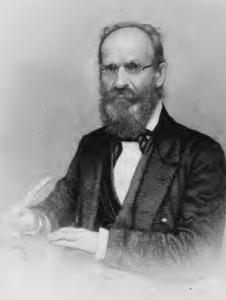 Platt Rogers Spencer, who is my 3rd cousin 5 times removed, was a social activist. In other words, he saw something that was socially or morally wrong, such as slavery, and he actively fought against it. These days that would mean protesting, lobbying, and blogging against it. Social activism has it’s place, but should be done in the proper way. Platt Spencer was a zealous promoter of the antislavery movement…an honorable cause. He was a prominent advocate of the abstinence movements. He was instrumental in founding business colleges in the United States, and was in organizing several business colleges in the United States, and he was an instructor in business colleges throughout the country.
Platt Rogers Spencer, who is my 3rd cousin 5 times removed, was a social activist. In other words, he saw something that was socially or morally wrong, such as slavery, and he actively fought against it. These days that would mean protesting, lobbying, and blogging against it. Social activism has it’s place, but should be done in the proper way. Platt Spencer was a zealous promoter of the antislavery movement…an honorable cause. He was a prominent advocate of the abstinence movements. He was instrumental in founding business colleges in the United States, and was in organizing several business colleges in the United States, and he was an instructor in business colleges throughout the country.
In 1815, Spencer taught his first writing class, and in New York, where he founded the Spencer Seminary in Jericho, housed in a log cabin. From 1816 to 1821, he was a clerk and a book keeper and, from 1821 to 1824, he studied in law, Latin, English literature and penmanship. He also taught in a common school and wrote up merchants’ books.  In 1824, he contemplated entering college with a view to preparing for the ministry, but, due to his alcoholism, which was aggravated by the prevalent drinking customs of the time, he did not. He struggled with alcoholism for a number of years. He then taught in Ohio, where in 1832, he was able to withdraw from alcohol completely, becoming a total abstainer. He advocated abstaining from alcohol for the remainder of his life. Soon after his recovery from alcoholism, he was elected to public office, as county treasurer of Ashtabula County, Ohio for twelve years. He also was a founding member of the Ashtabula County Historical Society established in 1838 and he was instrumental in collecting the early history of Ashtabula County, Ohio.
In 1824, he contemplated entering college with a view to preparing for the ministry, but, due to his alcoholism, which was aggravated by the prevalent drinking customs of the time, he did not. He struggled with alcoholism for a number of years. He then taught in Ohio, where in 1832, he was able to withdraw from alcohol completely, becoming a total abstainer. He advocated abstaining from alcohol for the remainder of his life. Soon after his recovery from alcoholism, he was elected to public office, as county treasurer of Ashtabula County, Ohio for twelve years. He also was a founding member of the Ashtabula County Historical Society established in 1838 and he was instrumental in collecting the early history of Ashtabula County, Ohio.
In 1840, Platt developed a beautiful and unique style of writing and named it after himself, calling it Spencerian Script. The penmanship style quickly became the standard in the United States from 1850 to 1925. It was considered the American de facto standard writing style for business correspondence prior to the widespread adoption of the typewriter. Platt used various existing styles as the inspiration for his unique oval-based style. His style could be written quickly and legibly and yet it still looked elegant, which made it perfect for business  correspondence, as well as personal letters. Immediately following his development of the Spencerian Script style, Platt began teaching it in the schools he established for the purpose of teaching his penmanship style. As soon as his students began to graduate, they started replicas of the Spencerian Script abroad, and then in 1850 it reached the common schools. Unfortunately, Platt Spencer never got to see the full success of his unique penmanship, because he died on May 16, 1864. Nevertheless, his sons made it their mission to bring their late father’s dream to fruition. They accomplished that feat by distributing Spencer’s previously unpublished book, Spencerian Key to Practical Penmanship, in 1866. Spencerian Script was gradually replaced in primary schools with the simpler Palmer Method developed by Austin Norman Palmer…which is sadly very plain by comparison. The Coca-Cola Company famously used Spencerian Script in its now famous logo, and continues to do so to this day.
correspondence, as well as personal letters. Immediately following his development of the Spencerian Script style, Platt began teaching it in the schools he established for the purpose of teaching his penmanship style. As soon as his students began to graduate, they started replicas of the Spencerian Script abroad, and then in 1850 it reached the common schools. Unfortunately, Platt Spencer never got to see the full success of his unique penmanship, because he died on May 16, 1864. Nevertheless, his sons made it their mission to bring their late father’s dream to fruition. They accomplished that feat by distributing Spencer’s previously unpublished book, Spencerian Key to Practical Penmanship, in 1866. Spencerian Script was gradually replaced in primary schools with the simpler Palmer Method developed by Austin Norman Palmer…which is sadly very plain by comparison. The Coca-Cola Company famously used Spencerian Script in its now famous logo, and continues to do so to this day.
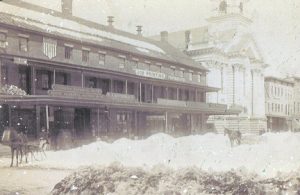 With all of the extreme weather shows, warnings, and education we have access to these days, one would think that blizzard related deaths would quickly become a thing of the past, but it never seems to go that way exactly. Nevertheless, it used to be much worse. In bygone years, the warnings we have today simply didn’t exist, and blizzards were very much feared by the people, and with good reason too. The storms would come up, seemingly without notice, and I suppose that was how it was. People couldn’t turn on their radio, television, computers, or smart phones, and get the weather forecast. They could look at the sky and feel the temperature changing, and maybe guess at what was coming, but if they were wrong, it could be deadly. Such was the case on January 12, 1888, when a blizzard blew into the Northwest Plains region of the United States with little or no warning. Some people said that the temperature dropped 100° in just 24 hours. A lot maybe, but I’ve seen temperature changes of more than 60°, so it’s possible.
With all of the extreme weather shows, warnings, and education we have access to these days, one would think that blizzard related deaths would quickly become a thing of the past, but it never seems to go that way exactly. Nevertheless, it used to be much worse. In bygone years, the warnings we have today simply didn’t exist, and blizzards were very much feared by the people, and with good reason too. The storms would come up, seemingly without notice, and I suppose that was how it was. People couldn’t turn on their radio, television, computers, or smart phones, and get the weather forecast. They could look at the sky and feel the temperature changing, and maybe guess at what was coming, but if they were wrong, it could be deadly. Such was the case on January 12, 1888, when a blizzard blew into the Northwest Plains region of the United States with little or no warning. Some people said that the temperature dropped 100° in just 24 hours. A lot maybe, but I’ve seen temperature changes of more than 60°, so it’s possible.
It was a Thursday afternoon and the weather had been unseasonably warm the previous day from Montana, east to the Dakotas, and south to Texas. Within a matter of hours, the Artic front blew in, plunging the temperature to 40° below zero in much of North Dakota. The freezing temperatures were joined by high winds and heavy snow. It was lethal combination that created a blinding blizzard, just when the children were on their 

 way home from school. The storm, coupled with the time of day, set the stage for a disaster, and unfortunately it would take the lives of 235 people…mostly children making their way home from school in rural areas and adults working on large farms. Both of these groups of people were taken by surprise, and were unable to find their way to their destinations.
way home from school. The storm, coupled with the time of day, set the stage for a disaster, and unfortunately it would take the lives of 235 people…mostly children making their way home from school in rural areas and adults working on large farms. Both of these groups of people were taken by surprise, and were unable to find their way to their destinations.
Some areas decided to err on the side of caution, and that resulted in lives saved. Schoolteacher, Seymour Dopp in Pawnee City, Nebraska, kept his 17 students at school when the storm began at 2 pm. They stayed overnight, burning stockpiled wood to keep warm. The next day, parents made their way over five foot snow drifts to rescue their children. I’m sure they were wondering if they would ever see their children again, because they couldn’t call to check on them, after all. Some areas ha drifts over ten feet too. In Great Plains,  South Dakota, two men rescued the children in a schoolhouse by tying a rope from the school to the nearest shelter to lead them to safety. Minnie Freeman, a Nebraska teacher, successfully led her children to shelter after the storm tore the roof off of her one room schoolhouse. Sadly, not all efforts to save the children were successful. Teacher Loie Royce tried to lead three children to the safety of her home, which was less than 90 yards from their school in Plainfield, Nebraska. They all became lost. The children died of hypothermia, and Royce lost her feet to frostbite. The January 12th storm was dubbed the Schoolchildren’s Blizzard, because most of the 235 victims were children. It is considered one of the worst blizzards in the history of the area, to this day.
South Dakota, two men rescued the children in a schoolhouse by tying a rope from the school to the nearest shelter to lead them to safety. Minnie Freeman, a Nebraska teacher, successfully led her children to shelter after the storm tore the roof off of her one room schoolhouse. Sadly, not all efforts to save the children were successful. Teacher Loie Royce tried to lead three children to the safety of her home, which was less than 90 yards from their school in Plainfield, Nebraska. They all became lost. The children died of hypothermia, and Royce lost her feet to frostbite. The January 12th storm was dubbed the Schoolchildren’s Blizzard, because most of the 235 victims were children. It is considered one of the worst blizzards in the history of the area, to this day.

![]() Yesterday, I heard the news that one of the iconic giant sequoia trees, located in Calaveras Big Trees State Park, in California’s Sierra Nevada Mountains, is gone. The tree had been hollowed out to allow cars to drive through it. The Pioneer Cabin Tree, usually referred to as simply the “tunnel tree,” is estimated to be over 1,000 years old. It was knocked over by a powerful winter storm that slammed into California on Sunday. While the tunnel had been carved out of the tree, it was still very much a living tree.
Yesterday, I heard the news that one of the iconic giant sequoia trees, located in Calaveras Big Trees State Park, in California’s Sierra Nevada Mountains, is gone. The tree had been hollowed out to allow cars to drive through it. The Pioneer Cabin Tree, usually referred to as simply the “tunnel tree,” is estimated to be over 1,000 years old. It was knocked over by a powerful winter storm that slammed into California on Sunday. While the tunnel had been carved out of the tree, it was still very much a living tree.
I immediately though back to a vacation my husband, Bob and I took a few years back, that took us through the scenic Redwood National Park in northern California. While the tree that we were able to drive through was not the one that was toppled in this storm, I still felt the loss of that amazing tree. The giant sequoia is the world’s largest tree, after all, and it is only found in the western slopes of the Sierra Nevada Mountains. It can reach a height of 325 feet. This particular tree, called the Pioneer Cabin Tree was actually hollowed out in about 1880. For a long time, cars drove through the iconic tree, but in recent years, it was only accessible by hiking trail. I thought about the tree we drove through, and how much fun it was to see such a huge tree. I was quite saddened by the loss of this beautiful tree.
Apparently, a volunteer, Jim Allday was in the park on Sunday when the tree came crashing down. It was about 2 pm, and the tree splintered on impact. The thing that he found most concerning was that visitors had been walking through the tree just hours earlier. He went out to the site to find the tree on the ground, and what ![]()
![]() looked like a pond or river running through it. The river was most likely the cause of the tree’s demise. The powerful winter storm brought heavy rain and snow to the area. It was the worst flooding in over a decade. The storm forced the closing of Yosemite National Park. It brought with it, hurricane-force winds of over 100 miles per hour. The wind and soggy ground were just too much for the giant tree. For people in the area, and anyone who has ever had the opportunity to see the tree and the park, it feels like losing a famous historical figure, and at 1,000, it was a great historical figure indeed.
looked like a pond or river running through it. The river was most likely the cause of the tree’s demise. The powerful winter storm brought heavy rain and snow to the area. It was the worst flooding in over a decade. The storm forced the closing of Yosemite National Park. It brought with it, hurricane-force winds of over 100 miles per hour. The wind and soggy ground were just too much for the giant tree. For people in the area, and anyone who has ever had the opportunity to see the tree and the park, it feels like losing a famous historical figure, and at 1,000, it was a great historical figure indeed.
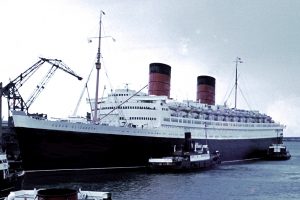 On September 27, 1938, the largest passenger ship of its time, the Queen Elizabeth, named after the wife of King George VI was launched. The ship was the epitome of luxury. And those fortunate enough to sail on it were treated to every luxury imaginable, at least until World War II came about. When World War II began, the Queen Elizabeth was sent to New York to protect it from German bombs. It was docked next to the Normandie and the Queen Mary, the other two largest passenger ships of the time. As the war progressed, the Queen Elizabeth was called into service as a troop transport ship. It carried nearly 1 million soldiers before the war ended. After the war, the ship returned to commercial service and became one of the dominant transatlantic carriers, hauling thousands of people back and forth between England and the United States. It was once again doing the work it was designed for.
On September 27, 1938, the largest passenger ship of its time, the Queen Elizabeth, named after the wife of King George VI was launched. The ship was the epitome of luxury. And those fortunate enough to sail on it were treated to every luxury imaginable, at least until World War II came about. When World War II began, the Queen Elizabeth was sent to New York to protect it from German bombs. It was docked next to the Normandie and the Queen Mary, the other two largest passenger ships of the time. As the war progressed, the Queen Elizabeth was called into service as a troop transport ship. It carried nearly 1 million soldiers before the war ended. After the war, the ship returned to commercial service and became one of the dominant transatlantic carriers, hauling thousands of people back and forth between England and the United States. It was once again doing the work it was designed for.
In 1968, the ship’s owner, the Cunard Steamship Company, sold the Queen Elizabeth. The purchasing company planned to make it a tourist attraction and hotel in Philadelphia. The plans were scrapped when the aging ship was deemed a fire hazard. Two years later it was sold to Hong Kong businessman CY Tung, who wanted to use the ship as a floating college. Tung renamed the ship, Seawise University and sent it to Hong Kong Harbor for refitting. On January 9, 1972, as the ship neared the completion of the £5 million conversion, it caught fire. The fire was thought by some to have been arson, because several blazes broke out simultaneously throughout the ship. The fact that CY Tung had acquired the vessel for $3.5 million, and had insured it for $8 million, led some to speculate that the inferno was part of a fraud to collect on the insurance claim. Others speculated that the  fires were the result of a conflict between Tung, a Chinese Nationalist, and Communist-dominated ship construction unions. Virtually, the entire Hong Kong firefighting force turned out to try to save the ship, but despite their heroic efforts over two long days, the ship turned on its side and sank to the bottom of the harbor, which was apparently not very deep, because over half of the ship could be seen above the water until it was dismantled and sold for scrap between 1974 and 1975, because it had been deemed a shipping hazard. Fortunately, no one was killed in the fire. Shortly before it was scrapped, the wreck served as the backdrop for a key scene in The Man With the Golden Gun, a 1974 James Bond film starring Roger Moore.
fires were the result of a conflict between Tung, a Chinese Nationalist, and Communist-dominated ship construction unions. Virtually, the entire Hong Kong firefighting force turned out to try to save the ship, but despite their heroic efforts over two long days, the ship turned on its side and sank to the bottom of the harbor, which was apparently not very deep, because over half of the ship could be seen above the water until it was dismantled and sold for scrap between 1974 and 1975, because it had been deemed a shipping hazard. Fortunately, no one was killed in the fire. Shortly before it was scrapped, the wreck served as the backdrop for a key scene in The Man With the Golden Gun, a 1974 James Bond film starring Roger Moore.
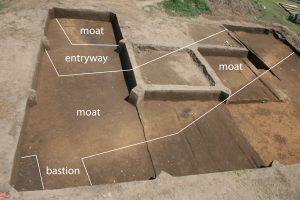 As the door closes on past eras of history, some things only exist in the memories of the people who lived it, and some things only exist in books or other writings. That doesn’t mean that they totally cease to exist, however. There are parts of the past that are still there…hidden, sometimes just under the surface, and sometimes a little way beneath the surface. Sometimes, there are clues on the surface, and other times, all you might have is a general location. Such is the case with Fort San Juan in western North Carolina. In 1566, Spanish explorer Juan Pardo began the first of two expeditions along the southeast coast of North America, establishing a series of forts in modern day South Carolina. The following year, Pardo travelled west, journeying almost 300 miles into what is now North Carolina. There, Pardo and his men constructed Fort San Juan and a small cluster of houses. Pardo named the settlement Cuenco, after his Spanish hometown.
As the door closes on past eras of history, some things only exist in the memories of the people who lived it, and some things only exist in books or other writings. That doesn’t mean that they totally cease to exist, however. There are parts of the past that are still there…hidden, sometimes just under the surface, and sometimes a little way beneath the surface. Sometimes, there are clues on the surface, and other times, all you might have is a general location. Such is the case with Fort San Juan in western North Carolina. In 1566, Spanish explorer Juan Pardo began the first of two expeditions along the southeast coast of North America, establishing a series of forts in modern day South Carolina. The following year, Pardo travelled west, journeying almost 300 miles into what is now North Carolina. There, Pardo and his men constructed Fort San Juan and a small cluster of houses. Pardo named the settlement Cuenco, after his Spanish hometown.
In 2013, a team of archeologists announced the discovery of the remains of a long lost 16th century Spanish garrison in western North Carolina that predates the earliest English settlements in North America by decades. Established in 1567, Fort San Juan was just one of at least six military installations built by the Spanish across the Appalachian mountain range, stretching from the coast of South Carolina to eastern Tennessee, and the only one of the forts scientists have located so far. Because Fort San Juan was established in 1567, time had taken its toll, and the information about it’s location was scarce, as was any visible trace of its location. Fort San Juan was one of at least six military installations that were built by the Spanish across the Appalachian mountain range, stretching from the coast of South Carolina to eastern Tennessee…and the only one of the 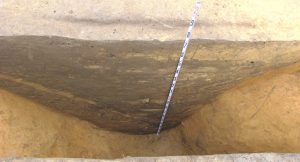 forts scientists have been able to locate so far. In the summer of 2013, a team of archeologists announced the discovery of the fort’s remains.
forts scientists have been able to locate so far. In the summer of 2013, a team of archeologists announced the discovery of the fort’s remains.
Archaeological work has been underway for years, revealing artifacts that suggested a Spanish settlement might have been there. During the summer of 2013, archaeologists affiliated with the University of Michigan, Tulane University and Warren Wilson College excitedly announced that they had discovered evidence of a defensive moat and other remains, definitive evidence of Fort San Juan. Nearly a decade ago, archeologists had found evidence of the soldier’s housing at Cuenco, but had been had not been able to locate the fort itself. The summer of 2013 changed all that, and was in fact it was completely by accident. The team, comprised of members from the University of Michigan, New Orleans’s Tulane University and Warren Wilson College in Asheville, North Carolina, was actually researching the Mississippian built mud mounds at the Joara site when they stumbled upon evidence of the remains of the fort. An initial dig turned up soil disturbances at the site that didn’t fit with what they expected. The team brought in a magnetometer to x-ray the subsurface. This 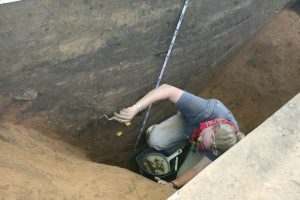 allowed them to identify the outlines of the moat was believed to have surrounded the garrison. Additional large scale excavations revealed its shape and size. A V-shaped area 5.5 feet deep, 12 to 15 feet across and up to 100 feet in length. In addition to the moat, the team recovered personal items belonging to the Spanish soldiers who lived and died at the fort, including pottery shards, nails, tacks, and iron hooks used for fastening clothing and swords. They also believe they located the gravel entry path into the garrison and the possible location of the strong house in a corner of the fort, where Spanish soldiers would have stored tools and weaponry. The group plans further excavations of the site next year.
allowed them to identify the outlines of the moat was believed to have surrounded the garrison. Additional large scale excavations revealed its shape and size. A V-shaped area 5.5 feet deep, 12 to 15 feet across and up to 100 feet in length. In addition to the moat, the team recovered personal items belonging to the Spanish soldiers who lived and died at the fort, including pottery shards, nails, tacks, and iron hooks used for fastening clothing and swords. They also believe they located the gravel entry path into the garrison and the possible location of the strong house in a corner of the fort, where Spanish soldiers would have stored tools and weaponry. The group plans further excavations of the site next year.

 Have you ever wondered why US money is green…or mostly green, while the money of so many other countries is very colorful? How did paper money come about anyway? Actually, paper money has been around in the United States since the beginning, off and on anyway. Printing paper money has been a controversial practice over the years. In 1861, as a means of financing the American Civil War, the federal government began issuing paper money for the first time since the Continental Congress printed currency to help pay for the Revolutionary War. The earlier form of paper dollars, dubbed continentals, were produced in such high volume that they soon lost much of their value. Devaluing our money has been a long standing problem with paper money. It’s simply too easy to print more money than we have gold to back.
Have you ever wondered why US money is green…or mostly green, while the money of so many other countries is very colorful? How did paper money come about anyway? Actually, paper money has been around in the United States since the beginning, off and on anyway. Printing paper money has been a controversial practice over the years. In 1861, as a means of financing the American Civil War, the federal government began issuing paper money for the first time since the Continental Congress printed currency to help pay for the Revolutionary War. The earlier form of paper dollars, dubbed continentals, were produced in such high volume that they soon lost much of their value. Devaluing our money has been a long standing problem with paper money. It’s simply too easy to print more money than we have gold to back.
In the decades before the Civil War, private, state chartered banks printed the paper money. Not surprisingly, this resulted in a wide variety of denominations and designs. Apparently, there was no real decision on how this should look. I guess they weren’t really worried about counterfeiting at that time. The bills that came out in the 1860s became known as greenbacks, because their backsides were printed in green ink. This ink was used as an anti-counterfeiting measure used to prevent photographic knockoffs, since the cameras of the time could only take pictures in black and white. I guess that counterfeiting had become a problem in the earlier years after all. And as we all know, the new scanners continue to improve the possibility of counterfeiting, making watermarks and security strips necessary too. And they have also added color to the money these days.
In 1929, the federal government decided that the paper money was too expensive to print, so in an effort to cut costs, they shrunk the size of all paper money. At the same time, they standardized the designs for each denomination, which made it easier for people to tell the difference between real and counterfeit bills. The new, more compact bills continued to be printed in green ink, because according to the US Bureau of Printing and Engraving, the ink was readily available and durable. They also thought that the color green represented stability. Today, there is some $1.2 trillion in coins and paper money in circulation in America. It costs about 5 cents to produce every $1 bill and around 13 cents to make a $100 bill, the highest denomination currently in 
 circulation. Don’t ask me why the difference, I would have expected them to be pretty much the same cost to manufacture. The estimated life span of a $1 bill is close to six years, while a $100 bill typically lasts 15 years, which makes sense to me, because we don’t use the $100 bill nearly as much. The $50 bill has the shortest average life span, at 3.7 years, and I would have expected the shortest lifespan to be the $1 bill, because we us those all the time.
circulation. Don’t ask me why the difference, I would have expected them to be pretty much the same cost to manufacture. The estimated life span of a $1 bill is close to six years, while a $100 bill typically lasts 15 years, which makes sense to me, because we don’t use the $100 bill nearly as much. The $50 bill has the shortest average life span, at 3.7 years, and I would have expected the shortest lifespan to be the $1 bill, because we us those all the time.

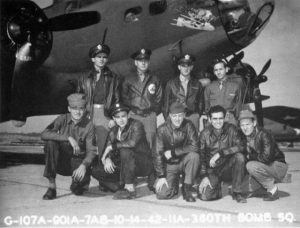 Every war has its casualties…it is an inevitable part of battle. World War II was no different, and in fact it was the deadliest war in world history, with casualties between 40,000,000 and 72,000,000. On average, 6,600 American servicemen died per month during World War II, about 220 a day. By the end of the war, over 40,000 airmen were killed in combat theatres and another 18,000 wounded. Some 12,000 missing men were declared dead, including a number liberated by the Soviets but never returned. More than 41,000 were captured, half of the 5,400 held by the Japanese died in captivity, compared with one tenth in German hands. As with any part of the war, being an airman in World War II was simply a very dangerous business.
Every war has its casualties…it is an inevitable part of battle. World War II was no different, and in fact it was the deadliest war in world history, with casualties between 40,000,000 and 72,000,000. On average, 6,600 American servicemen died per month during World War II, about 220 a day. By the end of the war, over 40,000 airmen were killed in combat theatres and another 18,000 wounded. Some 12,000 missing men were declared dead, including a number liberated by the Soviets but never returned. More than 41,000 were captured, half of the 5,400 held by the Japanese died in captivity, compared with one tenth in German hands. As with any part of the war, being an airman in World War II was simply a very dangerous business.
Over the years of World War II, there were many stories of men falling from their planes either from attack or accident. I’m sure some were just stories, but this is a true story. Staff Sergeant Alan Magee was born on January 13, 1919 in Plainfield, New Jersey, the youngest of six children of Resue and Doretta (Winn) Magee. Alan grew to be a short 5’7″ tall. That is short for a man, but slightly tall for a ball turret gunner on a B-17 bomber. Like many men, Alan joined the service right after the attack on Pearl Harbor. He was assigned as a ball turret gunner with the 303rd Bomb Group, 360th Squadron stationed at RAF Molesworth, which is a Royal Air Force station located near Molesworth, Cambridgeshire, England.
At 5’7″ inches, Magee was barely small enough to fit in the B-17’s ball turret. The ball turret was a cramped, donut shaped plastic glass and metal turret on the belly of the bomber. It was such a tight fit that a gunner’s knees were practically against his chest. Magee had to leave his parachute on the deck of the four engine Flying Fortress. That fact would prove to be detrimental. On January 3, 1943, Magee was assigned to a B-17, nicknamed “Snap! Crackle! Pop!” They were on a bombing run during the daytime over Saint Nazaire, France, also known at “Flack City,” when German fighters shot off a part of the right wing, causing the plane to enter a deadly spin. This was Magee’s seventh mission. That was an amazing feat in and of itself, because the life expectancy of a ball turret gunner in World War II was 12 minutes. It was really considered a suicide position on the plane. Oddly too, Magee was one of the oldest members of the 10 man crew at 24 years. The pilot, Captain Arthur Adams, was only 19, and this was only his third combat mission.
Magee was wounded in the attack, but managed to escape the ball turret, scrambling back into the cabin for his parachute. The only problem was that his parachute had been damaged and was totally useless, so having no other choice, Magee leapt from the spiraling plane without his parachute, losing consciousness rapidly because of the altitude. During his fall from the plane, Magee asked God to save his life. “I don’t wish to die because I know nothing of life,” was his appeal to God. Then, he totally lost consciousness and crashed through the glass roof of the Saint Nazaire train station. Eyewitnesses watched in horror as Magee came through the skylight. When he regained consciousness, Magee said to his captors: “Thank God I’m alive.” Magee’s injuries included 28 shrapnel wounds. A lung and kidney were hit. His nose and an eye were ripped open. His broken bones included his right leg and ankle. A right arm was nearly severed. The Germans decided that anyone who could miraculously survive such a fall deserved “real special attention.” It is thought that he fell over four miles before crashing through the glass roof. Some said they thought that the glass roof lessened Magee’s impact, and rescuers found him still alive on the floor of the station. It is my belief that God sent His angels to break the fall, because a 20,000 foot into a soft field can be fatal, so it is a miracle that he fell through a glass roof onto a concrete floor and lived. Magee regained consciousness in the first aid station before being transferred to the local hospital. “I owe the German military doctor who treated me a debt of gratitude,” said Magee. “He told me, ‘We are enemies, but I am first a doctor and I will do my best to save your arm.’” The doctor saved Magee’s arm and tended his other injuries, but unfortunately, Magee never found out the doctor’s name, so he couldn’t thank him. Staff Sargent Magee was taken as a POW and given continued medical treatment for his injuries by his captors. Magee was rescued in May 1945, and received the Air Medal for meritorious conduct and the Purple Heart. When the war was over, Magee got his pilot’s license and enjoyed flying. He worked a variety of jobs in the airline industry, and retired in 1979. He then moved to Northern New Mexico.
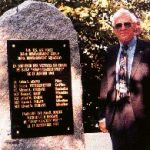
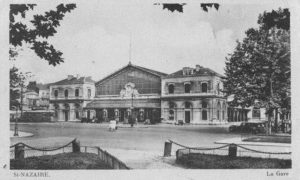 The people of Saint Nazaire, France honored Magee and the crew of his bomber on January 3rd, 1993 by erecting a six foot tall memorial to them. Alan Magee passed away in San Angelo, Texas on December 20th, 2003, at 84 from stroke and kidney failure. With the German doctors’ help, Magee fully recovered. Magee later hiked and backpacked and “led a pretty good life.” Two of his crewmen also survived. In all, 75 airmen died, seven U.S. planes were destroyed and 47 were damaged that day.
The people of Saint Nazaire, France honored Magee and the crew of his bomber on January 3rd, 1993 by erecting a six foot tall memorial to them. Alan Magee passed away in San Angelo, Texas on December 20th, 2003, at 84 from stroke and kidney failure. With the German doctors’ help, Magee fully recovered. Magee later hiked and backpacked and “led a pretty good life.” Two of his crewmen also survived. In all, 75 airmen died, seven U.S. planes were destroyed and 47 were damaged that day.

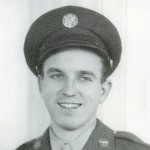 The mind of a soldier, in any branch of the service, is a mind that many of us do not understand. They go into situations that would send most of us running for the nearest hole to hide in, and then…when they write home or call home, they make light of the things they are doing…if they tell their family about their missions at all, because they don’t want to worry their loved ones. Often, if the family finds out about the missions they were on at all, it is years later. Maybe it is that they had to wrap their own minds around the things they had done, before they could tell anyone else about it. My dad, Allen Spencer was that way. In the letters he wrote home to his family, and especially his mother, his words were always very upbeat, very careful not to say the wrong things…things that might make them fear for his life, more than they already did. My nephew, Allen Spencer Beach, my dad’s namesake, is much like his grandfather in that way.
The mind of a soldier, in any branch of the service, is a mind that many of us do not understand. They go into situations that would send most of us running for the nearest hole to hide in, and then…when they write home or call home, they make light of the things they are doing…if they tell their family about their missions at all, because they don’t want to worry their loved ones. Often, if the family finds out about the missions they were on at all, it is years later. Maybe it is that they had to wrap their own minds around the things they had done, before they could tell anyone else about it. My dad, Allen Spencer was that way. In the letters he wrote home to his family, and especially his mother, his words were always very upbeat, very careful not to say the wrong things…things that might make them fear for his life, more than they already did. My nephew, Allen Spencer Beach, my dad’s namesake, is much like his grandfather in that way.
When Allen joined the Navy in 2009, it was to be part of the Naval Air Force. Part of his training was parachuting from a plane. At some point in his training, Allen injured his foot, and while the injury itself would not have stopped him from continuing in his chosen field, it delayed training long enough so that he wouldn’t be able to catch up with his class. It was at this point that Allen decided to become a medic. All of that information was known to most of his family at that time. It was certain parts of Allen’s work after that time that was only known to his family a number of years later. After the 7.0 earthquake that occurred in Haiti on January 12, 2010, Allen was one of the soldiers who was sent in to assist. I think most of us saw pictures of the devastation there, and the loss of life, but I seriously doubt that the news media showed us some of the worst parts of the devastation. It would be too much for many people to bare. I’m sure that is why Allen, like his grandfather, couldn’t tell his mother everything he did or saw. He had to process it himself, and put enough time between the event and his mother’s knowledge of it, so that hopefully she would not worry too much. I also have to wonder if his experience in Haiti is what made him decide to become a medic after his foot injury.
My sister, Caryl Reed, also found out, after the fact, that at one point, her son, Allen was training to be a medic for the Marines. Had he been needed, Allen would have become a medic on the front lines in a war zone. Here again, Allen knew that there needed to be enough time between the event and his mother’s knowledge of it, so she would not have nightmares. When she found out about that, all my sister could think was, “Thank the Lord that he didn’t have to go.” It was a mother’s second worst nightmares…the first being that her son actually goes to the front lines. A soldier has to push their own fear down as deep as they can, and make light of things with their loved ones, because they can imagine the anguish for their family, if they knew that truth…that they 
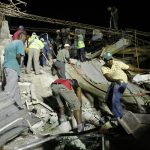 are in situations that really scare them, and they have no control over it. It is the experiences we live that help us to decide the direction our life will take. For Allen, what began as a career as maybe a pilot, has changed to a career in several different areas of medicine. From corpsman, to training as a field medic, to studying to be a hospital administrator. Allen left active duty in 2014, and lives in Washington DC, while his wife, Gabby finishes her service, and he finishes his studies. I know he will have a bright future. Today is Allen’s birthday. Happy birthday Allen!! Have a great day!! We love you!!
are in situations that really scare them, and they have no control over it. It is the experiences we live that help us to decide the direction our life will take. For Allen, what began as a career as maybe a pilot, has changed to a career in several different areas of medicine. From corpsman, to training as a field medic, to studying to be a hospital administrator. Allen left active duty in 2014, and lives in Washington DC, while his wife, Gabby finishes her service, and he finishes his studies. I know he will have a bright future. Today is Allen’s birthday. Happy birthday Allen!! Have a great day!! We love you!!

 It is so easy to focus on our own little planet, or our own little space, but the reality is that outside of our atmosphere, there is a huge space that makes us look like a speck of dust…if that. In centuries past, people could see the sun and the stars, and I suppose they considered the fact that there might be something else out there, but since they really had no way of viewing it better than using the naked eye, they just thought that it was what it was…somewhat like a curtain with holes poked into it, and they really didn’t ever expect to see anything more. Still, somewhere along the way, someone thought it might be possible to see further into the sky that just the few stars that were visible. Inventions came about to aid the people in seeing into the great beyond.
It is so easy to focus on our own little planet, or our own little space, but the reality is that outside of our atmosphere, there is a huge space that makes us look like a speck of dust…if that. In centuries past, people could see the sun and the stars, and I suppose they considered the fact that there might be something else out there, but since they really had no way of viewing it better than using the naked eye, they just thought that it was what it was…somewhat like a curtain with holes poked into it, and they really didn’t ever expect to see anything more. Still, somewhere along the way, someone thought it might be possible to see further into the sky that just the few stars that were visible. Inventions came about to aid the people in seeing into the great beyond.
One man who had a vision to be able to see what was out there, was Edwin Hubble. Edwin wanted to learn about space from the time he was a young boy. He said, “I knew that even if I were second or third rate, it was astronomy that mattered.” He knew that he simply couldn’t do anything else. That kind of 
 determination makes a person great, and he was determined. Hubble’s work was something his father didn’t understand, and didn’t want him to do, in fact making him promise to be a lawyer. Hubble tried, but his heart just wasn’t in it. He also worked as a teacher of Spanish, Physics, Mathematics, and coached basketball. His popularity as a teacher is recorded in the school yearbook dedicated to him: “To our beloved teacher of Spanish and Physics, who has been a loyal friend to us in our senior year, ever willing to cheer and help us both in school and on the field, we, the class of 1914, lovingly dedicate this book.”
determination makes a person great, and he was determined. Hubble’s work was something his father didn’t understand, and didn’t want him to do, in fact making him promise to be a lawyer. Hubble tried, but his heart just wasn’t in it. He also worked as a teacher of Spanish, Physics, Mathematics, and coached basketball. His popularity as a teacher is recorded in the school yearbook dedicated to him: “To our beloved teacher of Spanish and Physics, who has been a loyal friend to us in our senior year, ever willing to cheer and help us both in school and on the field, we, the class of 1914, lovingly dedicate this book.”
While Edwin Hubble’s father may have thought his son had made a terrible mistake, and that he was even one can short of a six-pack, Edwin Hubble knew that there was more to see out there, and he simply couldn’t sit idly by and miss God’s big show. In October 1923 he spotted what he first thought was a nova star flaring up dramatically in the M31 “nebula” in the constellation of Andromeda. After careful examination of photographic plates of the same area taken previously by other astronomers, including his greatest scientific rival, Harlow 
 Shapley, who thought that the Milky Way was the end of the universe, he realized that it was a Cepheid star. On December 29, 1924, all of his hard work came to fruition, when he made another startling find…all galaxies seemed to be receding from us with velocities that increased in proportion to their distance from us…a relationship now known as Hubble’s Law. On this day, December 30, 1924, Edward Hubble was finally able to make the announcement that would make his a household name…that the universe was not static, but ever expanding and that there were many other galaxies out there.
Shapley, who thought that the Milky Way was the end of the universe, he realized that it was a Cepheid star. On December 29, 1924, all of his hard work came to fruition, when he made another startling find…all galaxies seemed to be receding from us with velocities that increased in proportion to their distance from us…a relationship now known as Hubble’s Law. On this day, December 30, 1924, Edward Hubble was finally able to make the announcement that would make his a household name…that the universe was not static, but ever expanding and that there were many other galaxies out there.

